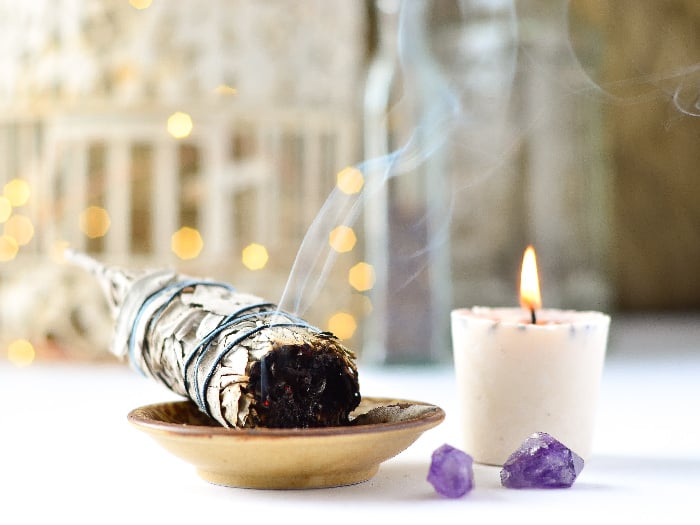White sage is a perennial evergreen herb that is primarily used to clean the air, improve the aroma and energy of a space, or it can be brewed as a tea for a variety of potential health benefits.
What is White Sage?
With the scientific name of Salvia apiana, white sage is also popularly known as sacred sage or bee sage. Found primarily in northern Mexico and the southwestern United States, such as in California and other desert regions. This shrub is found on the slopes of coastal sage shrub regions. It has evergreen leaves covered in hair that release aromas and oils when rubbed, burned, or steeped. The most commonly seen form of white sage is in small dried bundles, which has a more traditional or spiritual application. These bundles are burned for their aroma and as a tool in ‘scrubbing’ a home or area of bad energy/spirits. [1]

Smudging or burning sage is an ancient practice of cleansing spaces you live or work. Photo Credit: Shutterstock
Benefits
As mentioned above, white sage can have a number of benefits, depending on whether it is burned, topically applied or steeped in a tea, including helping to treat sinus infections and congestion, eliminating bacteria, reducing inflammation, aiding digestion, and cleansing a space of negative energy.
- Sinus Infections – If you burn white sage and inhale some of the smoke, be aware that it contains eucalyptol. It is an antioxidant compound that helps to eliminate pathogens and reduce inflammation in your sinuses. It can also have a similar effect on respiratory infections when consumed as a tea. [2]
- Antibacterial – When consumed as a brewed tea, white sage can help to reduce the presence of bacteria in your body. When burned in a larger space, it can reduce the bacteria in the air by as much as 90%, [3]
- Inflammation – According to this review from the Slovenian National AGRIS Centre, sage tea lowers joint pain and discomfort. The presence of phytoestrogens and other antioxidant compounds in sage means that it can help to reduce inflammation associated with menstruation, including cramps and hot flashes. [4] [5]
- Digestion – Traditionally, this herb was used to promote good digestion, as it can help to reduce the inflammation of hemorrhoids and promote healthy, normal bowel movements.
- Cleansing Spaces / ‘Scrubbing’ – Perhaps the most well-known use of white sage is the act of burning of dried white sage. It is traditionally associated with cleansing negative energy from a space. Beginning at the door of one’s home, sage is burnt and the house ‘scrubbed’ with sage smoke. The powerful aroma and smoke clear out ‘old air’ and negative energy from past experiences. [6]
- Stress and Anxiety – Some of the active ingredients of sage that are released when burnt are known to lower feelings of stress and tension, thus helping to lower chronic anxiety and related symptoms. [7]
Uses of White Sage
As explained above, there are various uses for white sage, including brewing a tea, binding dried leaves and burning them as incense, or applying them as a topical compress on the body.
- Tea – To make a tea from sacred sage, place two teaspoons of fresh sage leaves (or 1 teaspoon of dried sage leaves) in a mug. Fill the mug with boiling water and allow the leaves to steep for 2-3 minutes. Strain the tea and enjoy with lemon or honey. [8]
- Compress – Similar to brewing tea, you place 3-4 teaspoons of sage leaves in a bowl with warm or cold water (depending on whether you want a hot or cold compress). Place a piece of cotton in the steeped water and allow it to get soaked through. Place the soaked piece of cotton where you want relief and attach it in place with a gauze or a bandage.
- Burning / “Smudging” – If you buy your own bundle of dried sage leaves, follow the instructions in the section above. If you want to make your own, thoroughly clean the sage leaves, pat them dry, and then tie them into a bundle that is hung upside down. Let them air dry for 7-10 days before burning them. Some people will also cook the dried sage in an oven at 180 degrees for 30 minutes, in case any insects have found their way into the herbal bundle.
Side Effects
Some people have negative reactions to sage, particularly when it is drunk in the form of a tea. These side effects include nausea, vomiting, wheezing, rash, or fluctuations in blood pressure. If you experience any of these negative side effects, discontinue use immediately, as you may be allergic to this herb. When burnt or used for ‘scrubbing’, the smoke can cause eye or sinus irritation, especially if inhaled directly. These symptoms should pass very quickly. Topical irritation from an herbal compress is possible, but rare, and should also pass quickly if your skin is sensitive to the active compounds.
